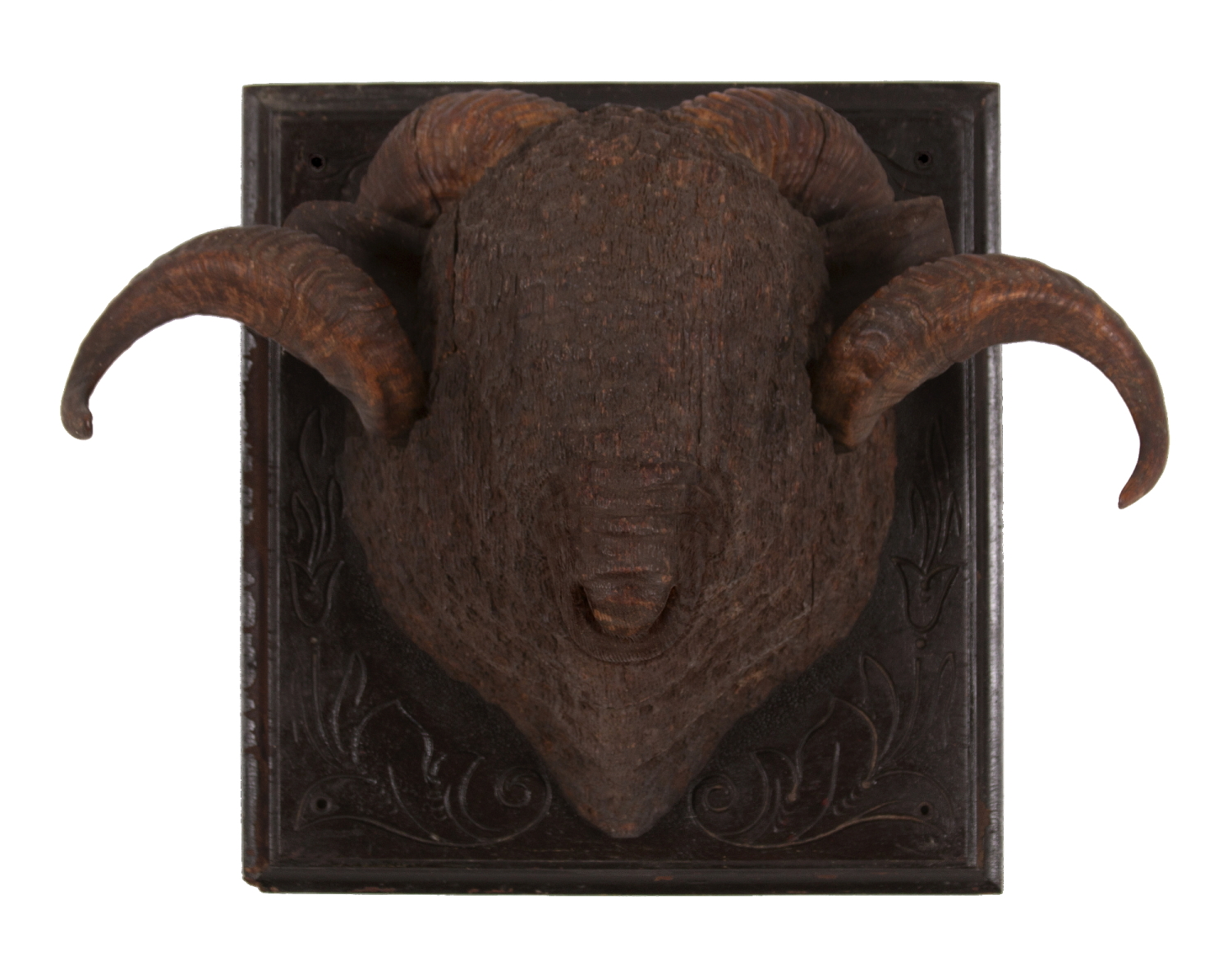
| |
ROBUST ORNAMENTAL CARVING OF A PRIZED RAM BY WEATHERVANE CARVER HENRY LEACH (1811-1885) OF MASSACHUSETTS, SIGNED & DATED 1876 |
| |
|
| Dimensions (inches): |
16" tall x 20" wide x 9.25" deep |
| Description: |
|
Born in 1811 in Montrose, Pennsylvania (northwest of Scranton, south of Binghamton, New York), self-trained wood carver Henry Leach (1811-1885) was the son of Mexican War officer Capt. Hezekiah Leach, Jr. (1774-1850) and his wife Ruth (Corbet) Leach (1780-1837), originally of Miford, Massachusetts. Henry’s grandparents were Connecticut-born Sarah Bartholomew of Harwington and her husband Hezekiah Leach, Sr. (1741-1823), of nearby Torrington, who enlisted in the Continental Army in 1781 at Litchfield and served with the 5th CT Troop (Colonel Sheldon’s Dragoons) during the Revolutionary War. One of Henry’s 6 siblings bore the name George Washington Leach and another Lucien Bonaparte. In keep with the family’s line of military service, Henry served in the Pennsylvania militia, rising to the rank of lieutenant colonel before traveling east to Boston, about 1847, where he operated a series of retail outlets on the waterfront, selling maps, books, clothing, and pens. The 1850 census lists his profession as simply “Hats,” in 1860 as “Trader,” and in the Massachusetts census of 1865, as “Pen Dealer.” Some time around 1865, Henry Leach opened an ornamental carving shop. In the 1870 census he lists his profession as “Carving” and in 1880 as “Wood Carver.” Operating in Boston until 1872, he then relocated his family to suburb of Woburn, where he continued to practice his craft until 1884. Returning to Pennsylvania, Leach passed in Montrose the following year.
While in Massachusetts, Leach was active in organizations of craftsmen and participated in annual expositions. A September 27th article in the Boston Evening Transcript, reports on his display at the “Tenth Exhibition of American Manufactures, New Inventions, and Works of Art,” held at Faneuil & Quincey Halls by the Massachusetts Charitable Mechanic Association: “H. Leach, Sculptor in Wood, and Ornamental Carver, has a magnificent display of carved work, embracing Animals Heads, including that of the classic ram that wore the Golden Fleece, the terrible bore, which figured at the dinner of feudal barons, also, those of the horse, the lion, the stag, the moose, the hog, the Placid cow, and the tender calf. There are also carvings from classical subjects—Amphitrite driving her chariot on the seas, Venus and Cupid, which will attract notice. A child feeding a cat and tenderly seeing a dog to become one of this happy family makes a very pretty group. The “Sleep of Summer and Dream of Joy” is beautifully executed. There are other carvings from the same hand and the whole are well worthy the attention of visitors.”
Within this era, Leach was hired by civil engineer turned weathervane maker Leonard W. Cushing, who, in 1865, with then-partner machinist Stillman White, bought out the equipment molds and designs of A.L. Jewel & Co. of Waltham, Mass. Based on Cushing’s journal and surviving Leach cartes de visite images, Leach carved numerous Cushing molds, including the Morgan horse Black Hawk, now at the Smithsonian, a Goddess of Liberty at the Shelburne Museum, a larger Goddess of Liberty in the collection of Mystic Seaport, as well as an eagle, a rooster, a setter (dog), and a peacock. Other known commissions range from likenesses of prized farm animals, household pets, elk, deer, and African exotic animals, to allegorical and mythological figures, to furniture.
This robust carving of a rams’ head is unique among Leach’s examples that I have seen. Though all are signed with his name and location, by way of metal dies, this is the only one that I know to be dated. Curiously, though the carving is exceptional, one must wonder if a child accompanied him in the shop, as the correct date “1876,” neatly rendered, is followed by 2 more attempts with combinations of the same 4 dies, including “6786, then “18” with the “76” upside-down. Census records show that the Leaches cared for numerous children. In 1870 their home included 3-year-old twins, apparently relatives of William H. McCarthy, widowed husband of their daughter, Ann (b. about 1836) widowed husband,. Ann seems to have passed shortly after their 1857 or 1858 marriage. Various McCarthy’s lived with the Leaches in both 1860 and 1870. The The family appears to have been well-off, as servants are listed in all census records, including 1850, 60, 65, 70, and 80.
By 1876. I expect most of the carvings done by Leach were by commission. The most likely purpose, in the late 19th century, would be of a prized animal. Executed with great texture and powerful folk style, the work is augmented by actual spiraling horns and may have belonged to the sheep in question, as a means of memorializing the animal. The bust is mounted on a carved and painted plaque, this example made of black walnut and incised with spiraling vines and tulips, the latter of which may be a vestige of Leach’s Pennsylvania heritage.
All-in-all, a remarkable carving from a well-documented personality whose hand contributed to numerous important fields in early American folk art.
Condition: Minor losses in the bottom left corner of the plaque and very minor in the top two. Moderate paint loss along the edges of the plaque. Some splits from age, but very structurally sound. |
|
|
| |
|
| Primary Color: |
brown |
|
| Earliest Date: |
1876 |
|
| Latest Date: |
1876 |
|
| For Sale Status: |
Available |
|
| Price |
$13,500 |
|
| E-mail: |
info@jeffbridgman.com |
|
 |
|
Page Views:... 553 |
|


